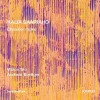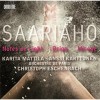| Country: | Finland |
| Period: | Contemporary classical music |
Biography
Kaija Saariaho (Finnish: [ˈkɑi̯jɑ ˈsɑːriɑho]; née Laakkonen, born 14 October 1952) is a Finnish composer.
Kaija Saariaho studied composition in Helsinki, Freiburg and Paris, where she has lived since 1982. Her studies and research at IRCAM have had a major influence on her music and her characteristically luxuriant and mysterious textures are often created by combining live music and electronics. Although much of her catalogue comprises chamber works, from the mid-nineties she has turned increasingly to larger forces and broader structures, such as the opera L’amour de loin, premiered at the 2000 Salzburg Festival[1] (with a US premiere at the Santa Fe Opera in 2002), and Oltra mar for chorus and orchestra, commissioned by the New York Philharmonic. Her second opera, Adriana Mater, was commissioned for the Opéra National de Paris’ 2006 season. Her second string quartet, Terra Memoria, was commissioned for the Emerson Quartet by Carnegie Hall for a June 2007 premiere. The third opera, Émilie, has the life and death of Émilie du Châtelet as its topic. The librettist of all of the three operas is Amin Maalouf.
Kaija Saariaho was born in Helsinki, where she attended the Helsinki Rudolf Steiner School, a school with a strong arts and music curriculum, for thirteen years[2] and studied violin and piano at the Sibelius Academy. She later studied in Freiburg (under Brian Ferneyhough and Klaus Huber) and at IRCAM in Paris. Most critics, however, cite spectral music composers Gérard Grisey and Tristan Murail as her largest influences. Her work in the 1980s and 1990s is marked by its emphasis on timbre and use of electronics alongside traditional instruments; Nymphéa (Jardin secret III) (1987), for example, is for string quartet and live electronics. It contains an additional vocal element: the musicians whispering the words to a poem by Tarkovsky. In the late 1990s Saariaho began to expand beyond electronics, often writing strictly acoustic pieces, focusing increasingly on melody.
Saariaho was influenced by post-serialism[clarification needed], but she grew to find it too restrictive: "You were not allowed to have pulse, or tonally oriented harmonies, or melodies. I don't want to write music through negations. Everything is permissible as long as it's done in good taste."[citation needed]
She has won the Prix Italia and, in 1989, the Prix Ars Electronica; received commissions from Lincoln Center for the Kronos Quartet and from IRCAM for the Ensemble Intercontemporain; and has been the subject of a pan-European collaborative project to produce a CD-ROM Prisma about her work.
In 2000 she won the Nordic Council Music Prize for the work Lonh for soprano and electronics.
She was awarded the title Musician of the Year 2008 (announced by Musical America, the US publishing company for performing arts), for being "among the few contemporary composers to achieve public acclaim as well as universal critical respect".
Invited by Walter Fink, she was the 20th composer featured in the annual Komponistenporträt of the Rheingau Musik Festival in 2010, the second female composer after Sofia Gubaidulina. Music included Sept Papillons for cello solo (2000), played by Anssi Karttunen, and Quatre Instants for soprano and piano (2002), performed by Pia Freund and David Lively. An orchestral concert with the SWR Sinfonieorchester, conducted by Susanna Mälkki, featured Aile du songe, a flute concerto with soloist Camilla Hoitenga, and Laterna Magica.

























